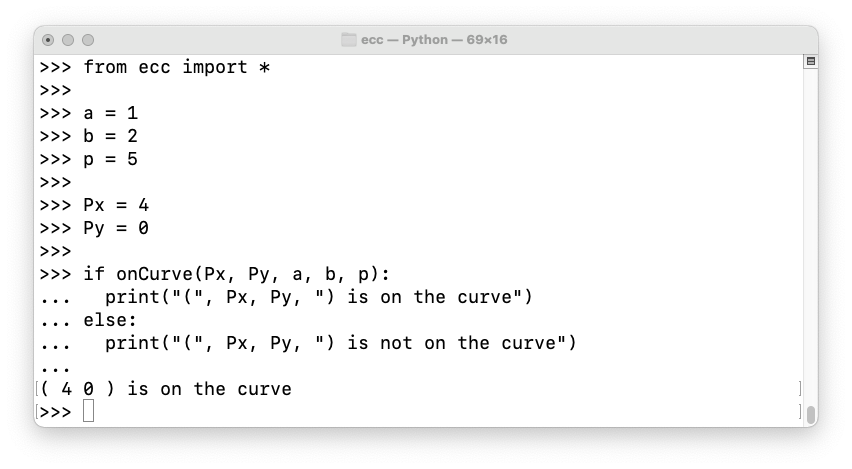
Each elliptic curve we'll use is defined by the two parameters a and b in the equation below.
y 2 = x 3 + ax + b mod pAll calculations are made modulus p. p is a prime number.
On your Mac or Linux machine, in a Terminal window, execute these commands:
wget https://gist.githubusercontent.com/sambowne/d8a3984f3ee987facae1133afee55648/raw/64306798a03a5340dc30889622c629416895debf/ecc.py
python3 -m pip install numpy
y 2 = x 3 + x + 2Consider the case x = -1. All the terms on the right side cancel out, so
y 2 = 0One solution is (x, y) = (-1, 0), which we can also write as (4, 0) (mod 5).
We can say the Point (4, 0) is on the curve.
We can determine whether a point is on the curve using the onCurve() function.
On your Mac or Linux machine, in a Terminal window, execute the commands below. Press Enter twice after the last command.
python3
from ecc import *
a = 1
b = 2
p = 5
Px = 4
Py = 0
if onCurve(Px, Py, a, b, p):
print("(", Px, Py, ") is on the curve")
else:
print("(", Px, Py, ") is not on the curve")

Let's find all the points on the curve.
On your Mac or Linux machine, in a Terminal window, execute the commands below. Press Enter twice after the last command.
from ecc import *
a = 1
b = 2
p = 5
for Px in range(p):
for Py in range(p):
if onCurve(Px, Py, a, b, p):
print(Px, Py, "is on the curve")
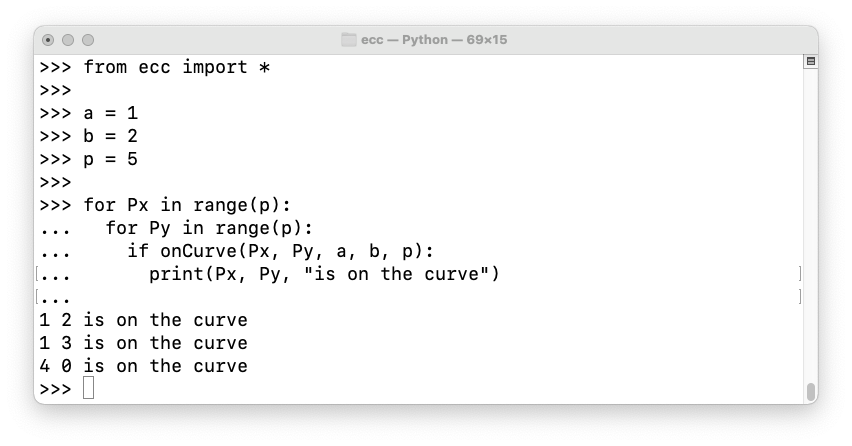
Let's change b to 1.
On your Mac or Linux machine, in a Terminal window, execute the commands below. Press Enter twice after the last command.
Now there are eight points on the curve (plus the point at infinity), as shown below.
The number of points on an elliptic curve varies, but it's never very far away from p, as explained here.
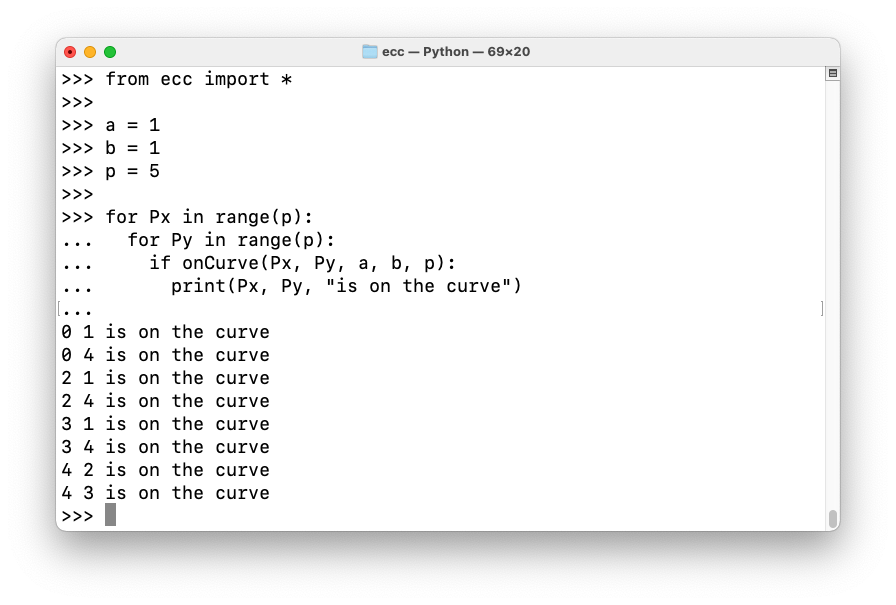
C 524.1: Secp256k1 (5 pts)
This is the curve used by Bitcoin, (with a higher p):How many points are on this curve, not including the point at infinity? That number is the flag.
- a = 0
- b = 7
- p = 11
C 524.2: Secp256k1 with Larger p (10 pts)
Use this curve:What is the largest y of any point on the curve, excluding the point at infinity? That number is the flag.
- a = 0
- b = 7
- p = 6199
eccScalarMult(k, Px, Py, a, b, p)As we saw before, here are the points on this curve:

Execute these commands to see various multiples of (0, 1):
from ecc import *
a = 1
b = 1
p = 5
Px = 0
Py = 1
for k in range(15):
print(k, "*", "(", Px, ",", Py, ") =", eccScalarMult(k, Px, Py, a, b, p))
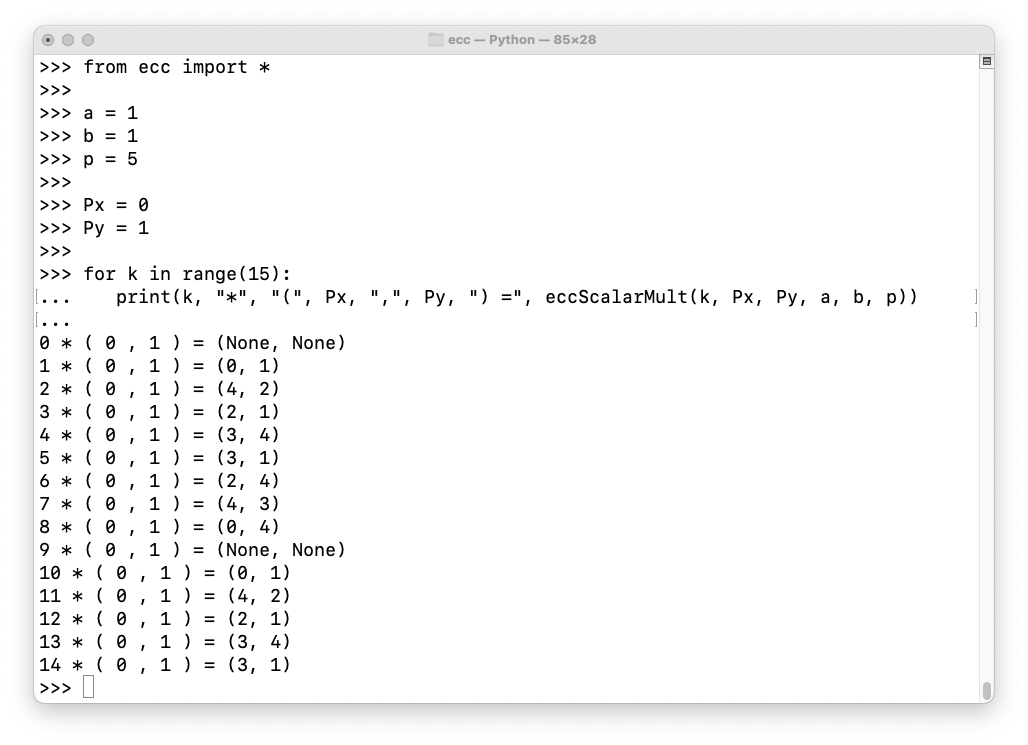
Execute these commands to list multiples of all eight points on the curve:
from ecc import *
a = 1
b = 1
p = 5
for Px, Py in [(0,1), (0,4), (2,1), (2,4), (3,1), (3,4), (4,2), (4,3)]:
for k in range(10):
print(k, "*", "(", Px, ",", Py, ") =", eccScalarMult(k, Px, Py, a, b, p))
print()
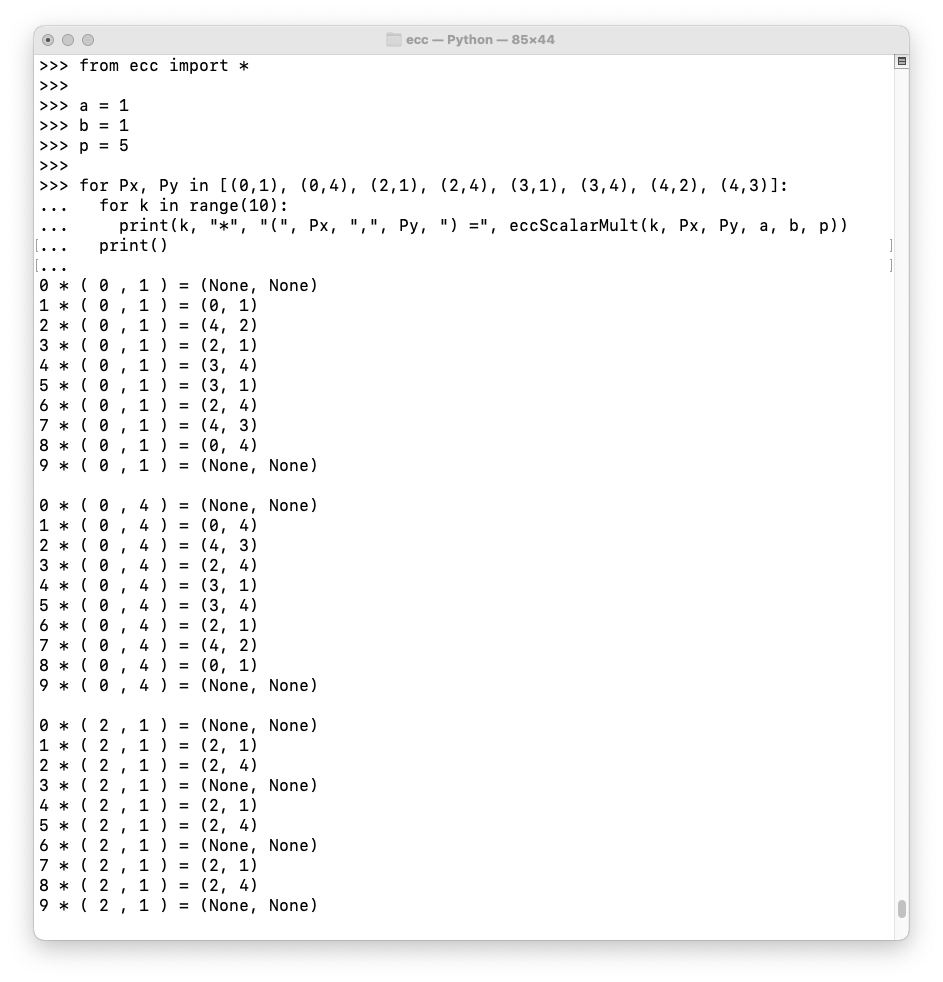
C 524.3: Generators (5 pts)
Use the curve defined below:How many points on this curve are generators? That number is the flag.
- a = 2
- b = 3
- p = 7
C 524.4: More Generators (10 pts)
Use the curve defined below:How many points on this curve are generators? That number is the flag.
- a = 2
- b = 3
- p = 101
Execute the code below to confirm that there are 17 points on this curve (not including the point at infinity), and that (15, 4) is a generator.
from ecc import *
a = 0
b = 7
p = 17
P = []
for Px in range(p):
for Py in range(p):
if onCurve(Px, Py, a, b, p):
P.append((Px, Py))
print("Number of points:", len(P), P)
Px = 15
Py = 4
for k in range(20):
Q = eccScalarMult(k, Px, Py, a, b, p)
print(k, "*", "(", Px, ",", Py, ") =", Q)
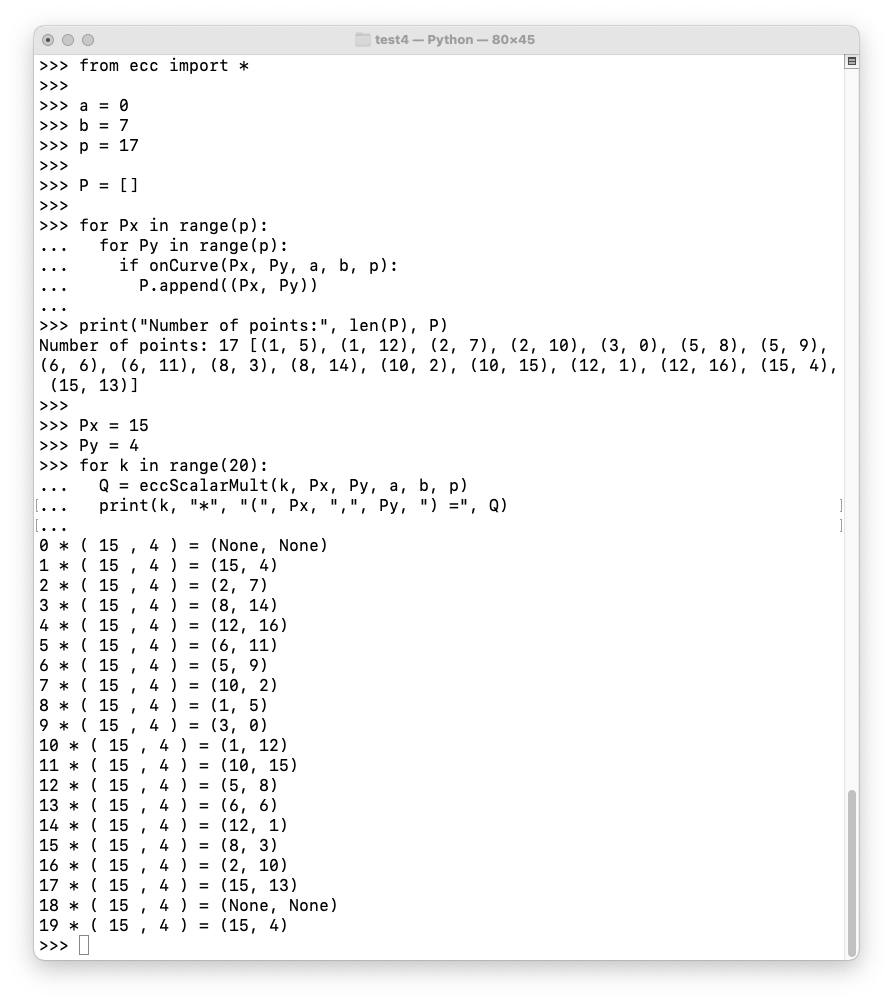
As shown below, they agree on a curve (Secp256k1), p, and a generator G. These parameters are not secret--they can be published to the public cloud.
Cueball picks a random number
α, between
1 and p - 1.
α is his
private key.
Cueball calculates his public key A =
αG , and publishes it to the
cloud.
Meghan chooses a private key of β, calculates her public key B = βG , and publishes it to the cloud.
Each of them multiplies their private key and the other person's public key to find a Shared Secret, as shown below.
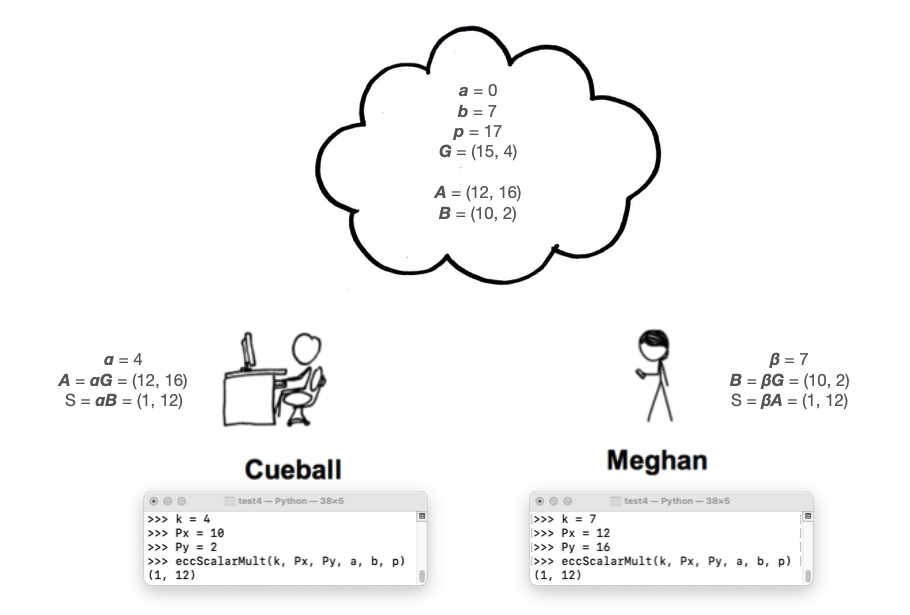
Unlike RSA, ECC does not provide any way to encrypt or decrypt with the public or private keys.
Instead, the Shared Secret can be used to determine an encryption key using PBKDF2 or some other algorithm, and the data can be encrypted with AES.
Given A, find α such that A = αGThis problem is very difficult if a good elliptic curve is chosen, with a large enough value of p.
C 524.5: ECDH (5 pts)
Use the curve defined below:Cueball 's private key is 94. What is his public key? That's the flag.
- a = 0
- b = 7
- p = 761
- G = (3, 107)
C 524.6: DLP (10 pts)
Use the same curve as in the previous challenge.Megan's public key is (744, 52).
Find her private key. That's the flag.
Cueball has:
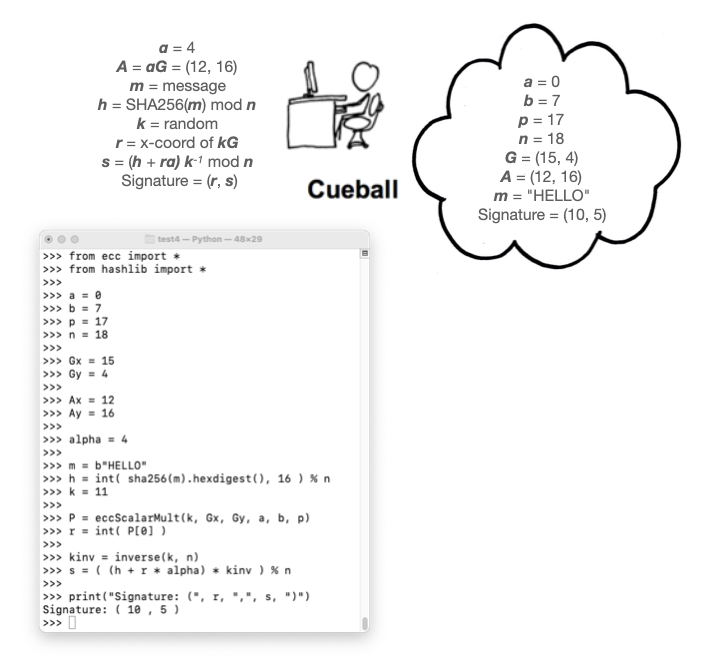
from ecc import *
from hashlib import *
a = 0
b = 7
p = 17
n = 18
Gx = 15
Gy = 4
Ax = 12
Ay = 16
alpha = 4
m = b"HELLO"
h = int( sha256(m).hexdigest(), 16 ) % n
k = 11
P = eccScalarMult(k, Gx, Gy, a, b, p)
r = int( P[0] )
kinv = inverse(k, n)
s = ( (h + r * alpha) * kinv ) % n
print("Signature: (", r, ",", s, ")")
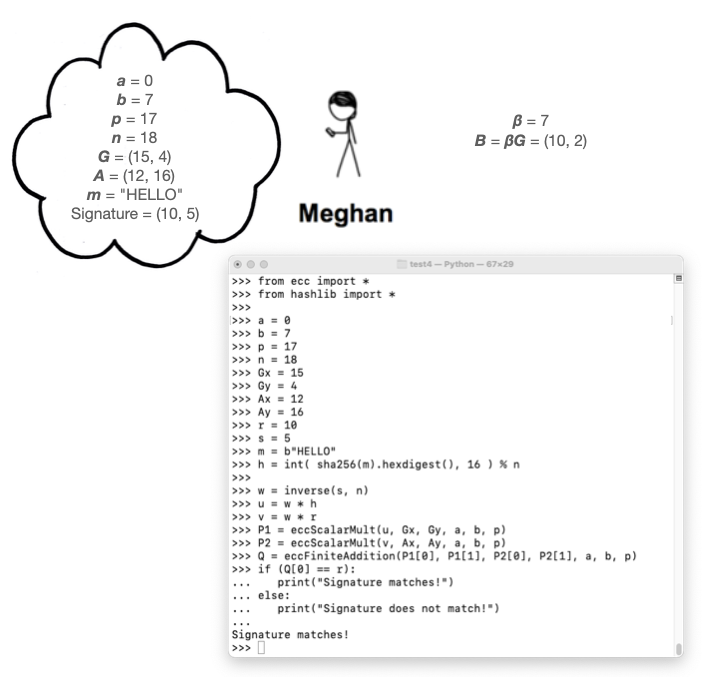
Execute these commands to verify Cueball's signature:
from ecc import *
from hashlib import *
a = 0
b = 7
p = 17
n = 18
Gx = 15
Gy = 4
Ax = 12
Ay = 16
r = 10
s = 5
m = b"HELLO"
h = int( sha256(m).hexdigest(), 16 ) % n
w = inverse(s, n)
u = w * h
v = w * r
P1 = eccScalarMult(u, Gx, Gy, a, b, p)
P2 = eccScalarMult(v, Ax, Ay, a, b, p)
Q = eccFiniteAddition(P1[0], P1[1], P2[0], P2[1], a, b, p)
if (Q[0] == r):
print("Signature matches!")
else:
print("Signature does not match!")
C 524.7: Meghan's ECDSA Signature (5 pts)
Megan wants to sign the same message, "HELLO". As shown in the image above, her private and public keys are:Use a k of 7, and the same curve as in the figure above.β = 7 B = (10, 2)Calculate Megan's signature. That's the flag.
C 524.8: Validate Meghan's ECDSA Signature (5 pts)
Validate Megan's signature. The flag is the value Q
Here's how Cueball creates a signature, as shown in the image below:
Execute these commands to calculate Cueball's signature:
from ecc import *
from hashlib import *
a = 0
b = 7
p = 17
n = 18
Gx = 15
Gy = 4
Ax = 12
Ay = 16
Abytes = bytes(hex(Ax) + hex(Ay), 'utf-8')
alpha = 4
m = b"HELLO"
r = 11
R = eccScalarMult(r, Gx, Gy, a, b, p)
Rbytes = bytes(hex(R[0]) + hex(R[1]), 'utf-8')
e = int( sha256(Rbytes + Abytes + m).hexdigest(), 16 ) % n
s = r + alpha * e
print("Signature: (", s, ",", R, ")")
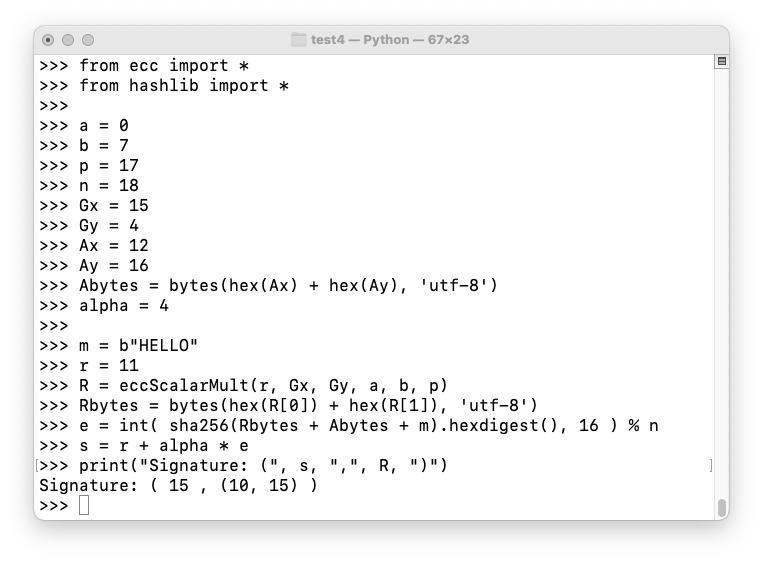
Execute these commands to verify Cueball's signature:
from ecc import *
from hashlib import *
a = 0
b = 7
p = 17
n = 18
Gx = 15
Gy = 4
Ax = 12
Ay = 16
Abytes = bytes(hex(Ax) + hex(Ay), 'utf-8')
m = b"HELLO"
R = (10, 15)
Rbytes = bytes(hex(R[0]) + hex(R[1]), 'utf-8')
s = 15
c = eccScalarMult(s, Gx, Gy, a, b, p)
e = int( sha256(Rbytes + Abytes + m).hexdigest(), 16 ) % n
Ae = eccScalarMult(e, Ax, Ay, a, b, p)
d = eccFiniteAddition(R[0], R[1], Ae[0], Ae[1], a, b, p)
if c==d:
print("Signature is valid!")
else:
print("Signature is not valid!")
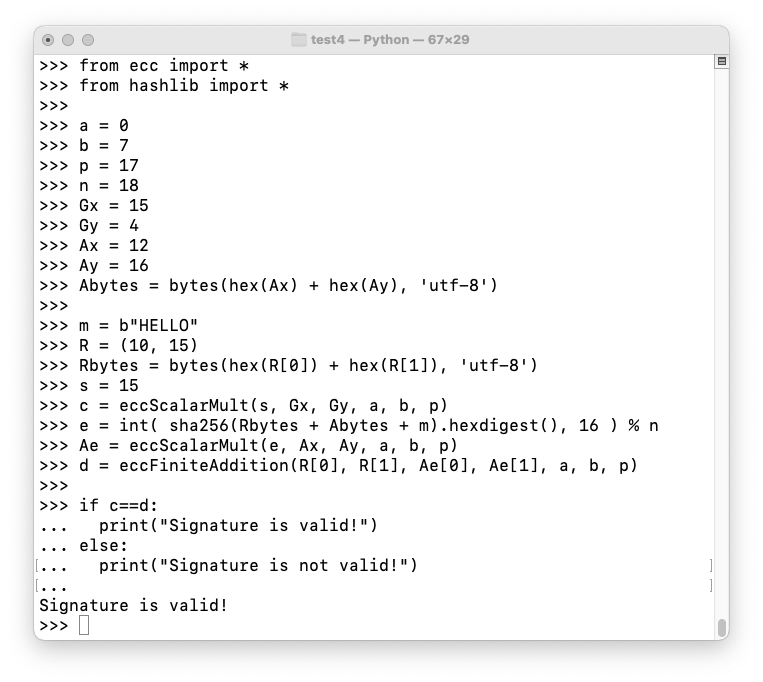
C 524.9: Meghan's Schnorr Signature (5 pts)
Megan wants to sign the same message, "HELLO". Her private and public keys are:Use a r of 5, and the same curve as in the figure above.β = 7 B = (10, 2)Calculate Megan's Schnorr signature. That's the flag.
C 524.10: Validate Meghan's Schnorr Signature (5 pts)
Validate the signature you found above. The flag is the d value.
Cueball and Meghan both want to sign a message.
Here's how they do it:
from ecc import *
from hashlib import *
a = 0
b = 7
p = 17
n = 18
G = (15, 4)
A = (12, 16)
B = (10, 2)
PAB = eccFiniteAddition(A[0], A[1], B[0], B[1], a, b, p)
PABbytes = bytes(hex(PAB[0]) + hex(PAB[1]), 'utf-8')
rA = 11
RA = eccScalarMult(rA, G[0], G[1], a, b, p)
rB = 13
RB = eccScalarMult(rB, G[0], G[1], a, b, p)
RAB = eccFiniteAddition(RA[0], RA[1], RB[0], RB[1], a, b, p)
RABbytes = bytes(hex(RAB[0]) + hex(RAB[1]), 'utf-8')
m = b"HELLO"
e = int( sha256(RABbytes + PABbytes + m).hexdigest(), 16 ) % n
alpha = 4
sA = rA + alpha * e
beta = 7
sB = rB + beta * e
sAB = sA + sB
print("Signature: (", sAB, ",", RAB, ")")
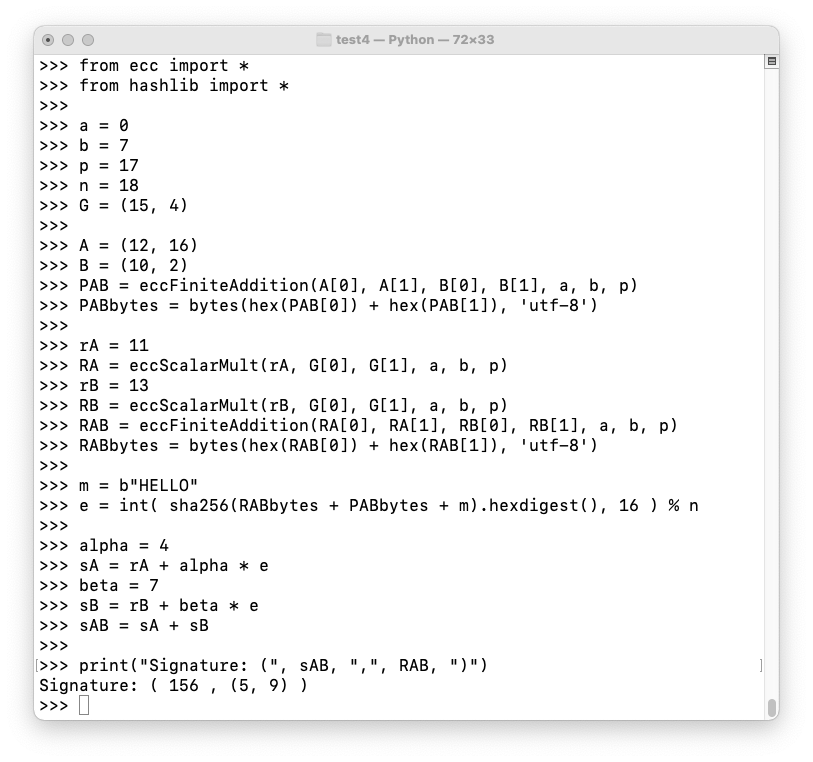
Execute these commands to verify the aggregate signature:
from ecc import *
from hashlib import *
a = 0
b = 7
p = 17
n = 18
G = (15, 4)
A = (12, 16)
B = (10, 2)
PAB = eccFiniteAddition(A[0], A[1], B[0], B[1], a, b, p)
PABbytes = bytes(hex(PAB[0]) + hex(PAB[1]), 'utf-8')
sAB = 156
RAB = (5, 9)
c = eccScalarMult(sAB, G[0], G[1], a, b, p)
RABbytes = bytes(hex(RAB[0]) + hex(RAB[1]), 'utf-8')
m = b"HELLO"
e = int( sha256(RABbytes + PABbytes + m).hexdigest(), 16 ) % n
PABe = eccScalarMult(e, PAB[0], PAB[1], a, b, p)
d = eccFiniteAddition(RAB[0], RAB[1], PABe[0], PABe[1], a, b, p)
if c==d:
print("Signature is valid!")
else:
print("Signature is not valid!")
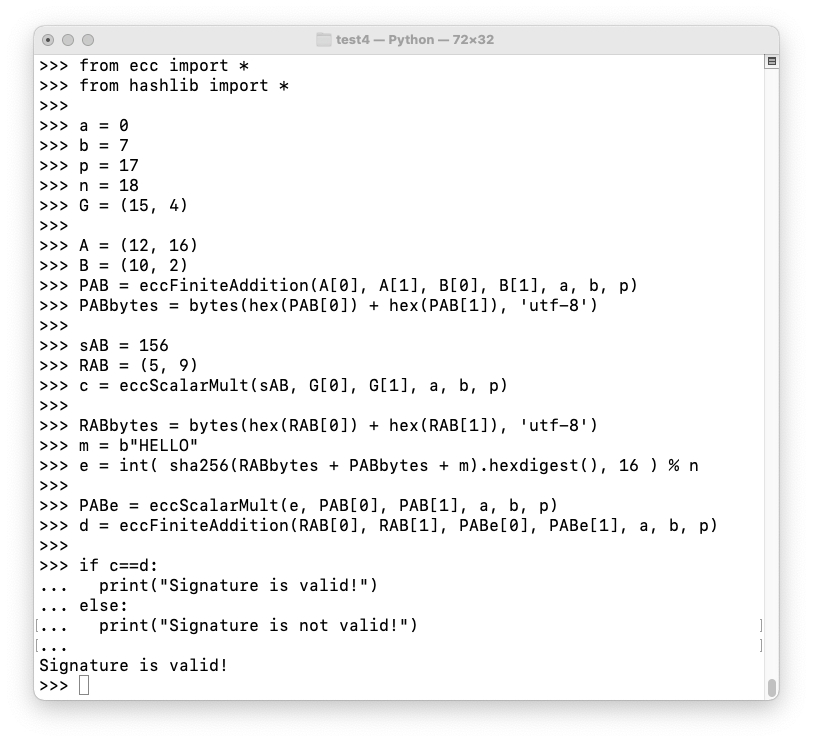
C 524.11: Aggregate Schnorr Signature (5 pts)
Add Ponytail, shown below, to the aggregate signature above, so there are three signers.Use an r of 3.
The composite Schnorr signature is the flag.
C 524.12: Validate the Aggregate Schnorr Signature (5 pts)
Validate the signature you found above. The flag is the d value.
Posted 11-21-21
Minor format fix, flag 524.2 answer corrected 4-23-25